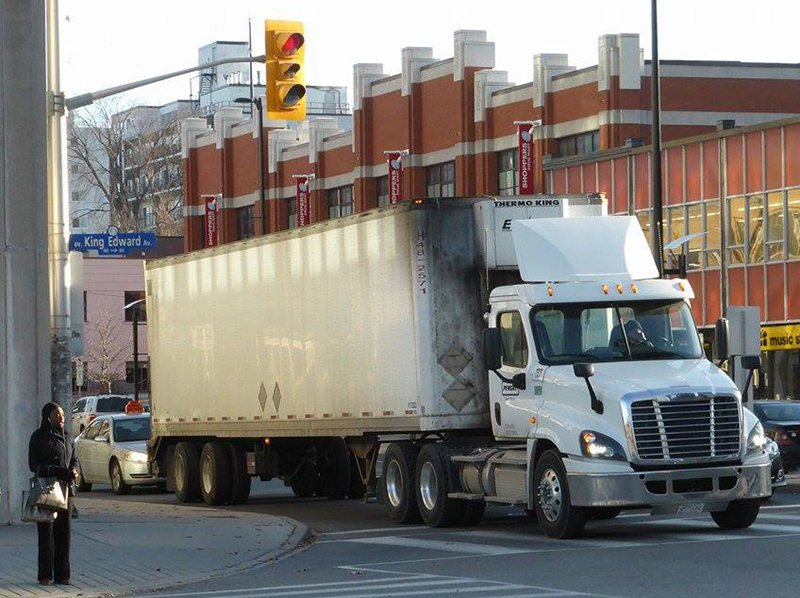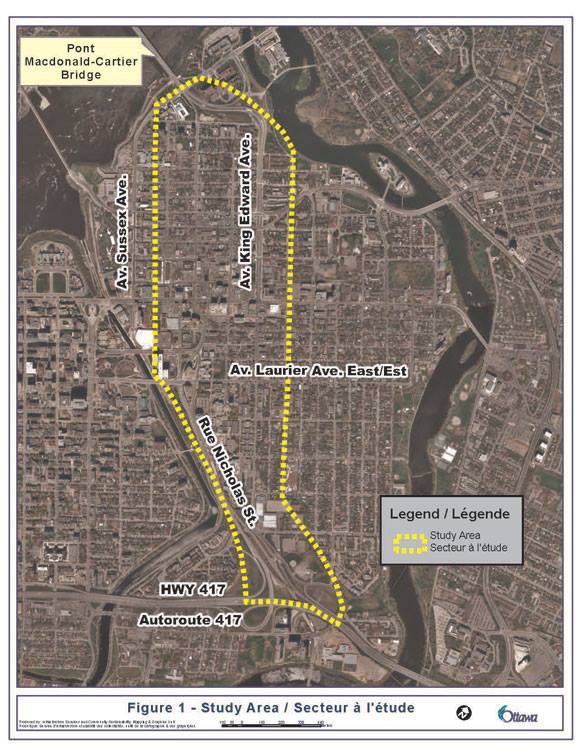By Karen Henderson

Megan Leah had no idea that roughly 140 transport trucks travelling through her neighbourhood every day contain dangerous goods.
“We don’t tend to think about what’s in the trucks, we just think of the trucks,” said Leah. “We don’t think about the dangers on the street.”
Leah works at the Champagne Fitness Centre on King Edward Avenue and deals with complaints from frustrated customers trying to access their parking lot, cross the road, or cycle down the street.
Every day, an average of 2,600 transport trucks travel across Highway 417, through Lowertown on King Edward Avenue and across the Macdonald-Cartier Bridge to Gatineau. One hundred and forty of those trucks carry dangerous goods, according to the 2007 Interprovincial Roadside Truck Survey.
Dangerous goods, as defined by the Ontario Ministry of Transportation, are substances that “could cause harm to people, property or the environment” such as petroleum, crude oil, or chemicals.
Kate Carradine, manager of the Andrew Fleck Child Care Services located at the intersection of George Street and King Edward Avenue, is concerned about how a potential spill could harm the children she cares for daily.
“If these goods are toxic then this is obviously a huge concern due to the fact that we have over 85 children in attendance at the centre and this could pose a serious safety risk should there ever be an accident of any kind,” said Carradine in an email.
A 2013 study by the Fraser Institute found risk of an oil spill is higher during road transport than it is when rail, marine or pipelines move oil products.
On Tuesday the federal standing committee on transport, infrastructure and communities met for the fourth and final time to review dangerous goods transport regulations. The committee examined transportation safety guidelines and regulation of dangerous goods transport for rail, air, sea and road across the country.
This review was spurred by federal Minister of Transport Lisa Raitt in 2013, shortly after the Lac Mégantic rail disaster.
Mathieu Fleury, city councillor of Rideau-Vanier Ward, said that a truck tunnel built downtown could relieve 93 per cent of truck traffic and possibly 100 per cent if the tunnel “is engineered properly” to accommodate transport trucks carrying dangerous goods. The City of Ottawa has hired Parsons Engineering to complete a feasibility study on the proposed truck tunnel. The study will be completed in 2015. Previously, the City had partnered with the province to assess building a bridge to reroute the truck traffic, but the province pulled support from the plan in 2013.

Some Lowertown residents have reservations about the efficacy of the truck tunnel and the probability of it being built in the near future.
Nathan Davis, co-chair of the King Edward Avenue Task Force and an ocean engineer employed with the Department of National Defence, said “I’m skeptical about the ability of the tunnel to solve the trucking problem.”
Davis called the current truck situation on King Edward Avenue “an urban planning absolute fail.”
Davis said many trucks have overturned in recent years at the northern end of King Edward Avenue and that speed was a factor in these crashes.
Davis said a dangerous goods spill near the Macdonald-Cartier Bridge would be “an absolute disaster” due to the high residential population in that area and the nearby waterway.
An accident in this region of the city would be of particular concern because of the high population density. The population density of Lowertown is four-times the Ottawa average, according to the 2011 Ottawa Neighbourhood Study.
Transport Canada statistics show that Ontario has the highest number of emergency dangerous goods spills in Canada, with 308 reported emergencies in 2013. Road-related spills constituted 204 of the reports.
Fleury confirmed the feasibility study for the truck tunnel would not be completed until 2015 and estimates that the tunnel will be approved no earlier than 2017. The approval of the truck tunnel will be dependent on funding and support.
